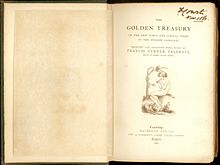Friday, 28 September 2012
A Tip from Thomas Woolner
Palgrave's Golden Treasury is probably the most famous poetry anthology of them all (unless it's the rather less widely read Greek Anthology) and is certainly the best to have come out of the Victorian age; it's still - after many revisions and updates - a very handy book to have around. The man who compiled it, Francis Turner Palgrave - born on this day in 1824 - was one of those Victorians who seemed to have the energy to live several parallel lives (as poet, critic, educator, civil servant and committee man) and who knew everybody who was anybody. He was a close friend of Tennyson, and an even closer friend of the sculptor and poet Thomas Woolner, with whom he shared a house (though Woolner, it should be pointed out, was a robustly heterosexual married man and father of six). The rather fey engraving on the original Golden Treasury title page is from a drawing by Woolner.
An interesting figure with a forceful, by all accounts rather 'rough' personality, Woolner was, despite his strongly classical leanings, a founder member of the Pre-Raphaelite Brotherhood - the only sculptor among them - and his temporary emigration to Australia in 1852 inspired Ford Madox Brown's doomy painting The Last of England. Like Palgrave, Woolner too was a friend of Tennyson, and provided him with the scenario for the great narrative poem Enoch Arden. But it was his friendship with Darwin that bore the strangest fruit, when the two men discussed the formation of the ear of Woolner's sculptured Puck. Darwin identified this particular formation as an atavistic feature and gave it the name of the 'Woolnerian tip'. It is now known, more prosaically, as Darwin's tubercle - and my daughter and I both have a rather more attractive version of it. We call it our 'pixie ear'.

Ah, I was rather hoping that Sam would have our pixie ear! But he's perfectly symmetrical. His ears are lovely in their own way of course...
ReplyDelete